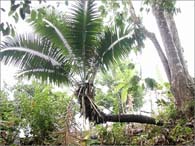
TAGUA



Tagua seed pods are among nature's most exquisite treasure boxes. They are as large as a man's head, and weigh from ten to twenty pounds. Each mighty pod contains from fifty to ninety nuts. Rough and spiny on the exterior, the pods are very beautiful within. They are filled with soft, pink pulp that is as fine as cotton. Snugly packed away in this pulp are small bags of sweet juice, which soon change into little lumps of sweet pulp, and then harden into the fat nuts which possess the color and the texture of dentine ivory.
The pods of the Tagua remain tightly
closed until the little nuts they hold are fully ripe and hard enough
to withstand the determined drilling of a grub which likes the nuts as
a dwelling place. When the time comes, the big pods burst open at the
lower end and pour the contents out upon the ground. Then come
scampering dozens of furred creatures whose teeth and tongues remove
the sweet, sticky pulp in which each nut is wrapped. Every nut is
licked as clean as if it had been washed by this odd volunteer brigade
and all that man has to do to harvest this valuable crop is to bend his
back and pick it up!
The Tagua palm is one of the world's master producers. It requires a
full year to bring its nuts to maturity, but during that time it is not
idle; instead, it is running several side lines that it will eventually
bring up to the main line of production! While it is developing its
green nuts, it is also producing fragrant white blossoms. As a matter
of fact, the whole plant is used – nothing goes to waste! The
roots are used medicinaly for their diuretic properties. The stalks are
used for making floors. The shoots are edible when cooked. The leaves
make great roofs. And the flowers’ straw is used to make
brooms. The seeds are used to make beverages when they are unripe and
are eaten when they are ripe. At the same time all of this is going on,
the Tagua Palm is busy dumping on the market bushels full of nuts which
once polished have the same characteristics as ivory. This is why the
Tagua nut is known as "the vegetable ivory."
The Tagua palm grows in Panama, Columbia, Peru and Ecuador, but it is in the latter country that it reaches its greatest perfection. Thousands of tons of the nuts are harvested in Ecuador each year. The nuts are used to make beautiful carved figurines, necklaces, buttons and other accessories.
The handycrafts are made of tagua and tropical seeds, the seeds are cuted, polished and dyed from the french workshop Octambul;
All the models
are designed and created by Dominique Eelbo
